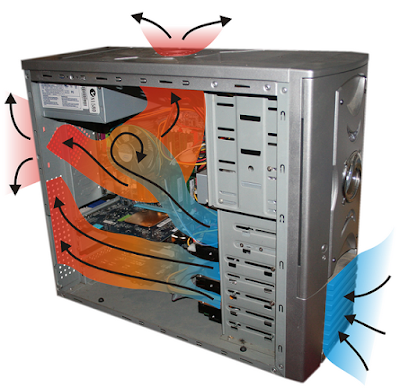Air cooling vs Liquid cooling: a brief discussion
There are a lot of heat sources
in a computer system: almost any component generates heat such as CPU, RAM, GPU
etc. Most of them include their own heatsinks which in some cases are passive
and in some other cases are energetic. Passive heatsinks are components which
can be adjusted on the surface of the element and guide the heat through it. Heat
is dissipated on the air. Energetic cooling mechanisms are also properly
mounted on the element and have a fan which helps in the heat dissipation.
Energetic cooling mechanisms
include air and water cooling systems. Next, a brief discussion on the basic
air and liquid cooling mechanisms will follow.
An air circulation system used
typically in PCs is depicted at the image following:
On the other hand, a liquid cooling system is:
The cost of air cooling
systems contain the proper placement of a few fans along the box of the
computer such that the air flow goes from the front part of the computer
towards the upper back part of the computer. The cost of the liquid cooling
system is higher than this of air cooling since it includes pipelines, the fridge,
the fluid and a pump which circulates the fluid.
Air cooling systems with fans are
proper for the average user which is not pushing the system very hard. Liquid
cooling systems are more proper for gamers and high-demanding users whose computer
systems generate a lot of heat due to high usage.
In the case of over-clocking, a more
effective cooling method is using liquid nitrogen which is a super-cold liquid.
Many over-clockers around the world use liquid nitrogen to get rid of the big
amounts of heat generated during over-clocking.
Another exotic method to get rid
of heat is immersing the system inside a non-conducting liquid. This method was
popular among hobbyists but companies have recently paid attention to it and
they offer commercial solutions already.



Δεν υπάρχουν σχόλια:
Δημοσίευση σχολίου